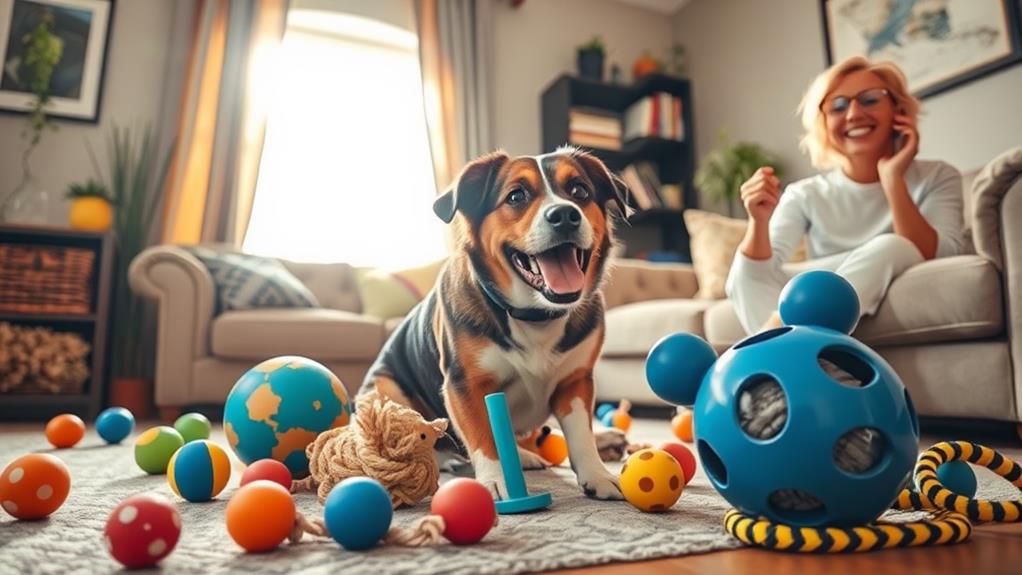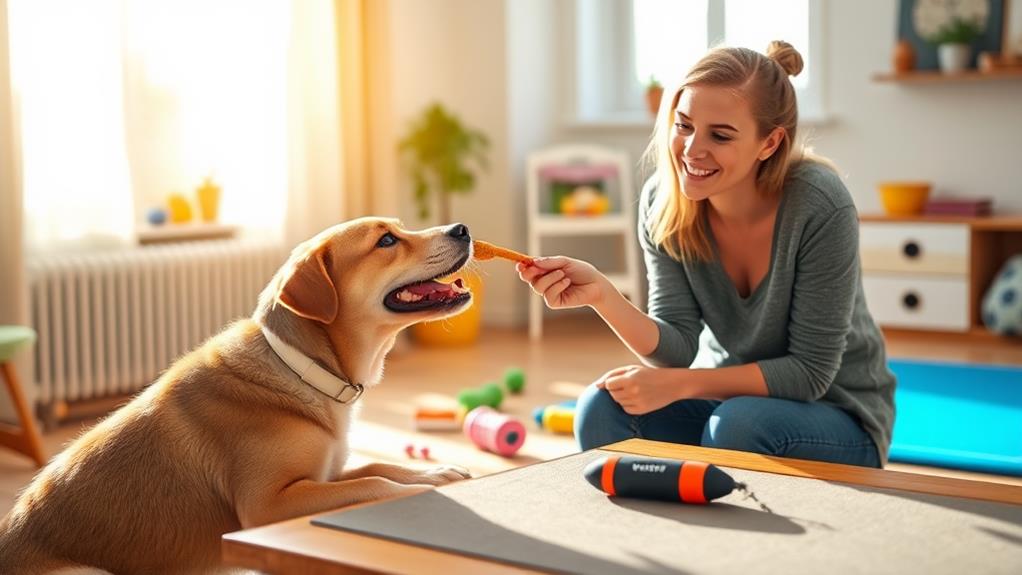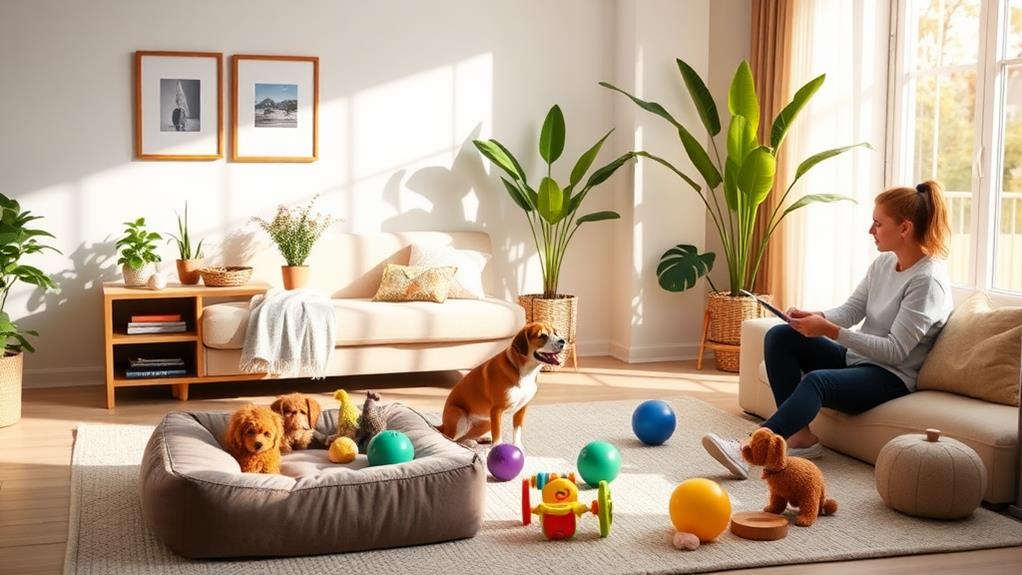Making a few lifestyle tweaks can help curb your dog's behavioral issues. Start by establishing a consistent routine with regular feeding, daily walks, and designated playtime. Increase their physical activity through games like fetch and agility training. Enhance their mental stimulation with puzzle toys and new tricks. Create a safe space where your dog can relax, and use positive reinforcement to reward good behavior. Limit exposure to stressors by identifying triggers and socializing with other dogs. Regular vet checkups can also guarantee their overall well-being. There's more to explore on how these strategies can transform your dog's behavior.
Establish a Routine

Establishing a routine is essential for your dog's well-being and can greatly reduce behavioral issues. Dogs thrive on predictability, and when you create a consistent schedule, it helps them feel secure. Start by setting regular feeding times. This not only aids in digestion but also helps manage their energy levels throughout the day.
Next, incorporate daily walks and play sessions into your routine. Even short, frequent outings can make a world of difference in keeping your dog mentally stimulated and less prone to anxiety or boredom. Additionally, designate specific times for training and commands to reinforce good behavior.
Don't forget about quiet time. Just like people, dogs need downtime to relax and recharge. Establishing a cozy spot for them to retreat to can help manage overstimulation.
Increase Physical Activity

Building on a consistent routine, increasing your dog's physical activity can greatly improve their behavior. Regular exercise helps burn off excess energy, reducing anxiety and destructive tendencies. Whether it's daily walks, playtime at the park, or engaging in dog sports, the options are endless.
Here's a simple guide to varying your dog's activity:
| Activity Type | Duration | Frequency |
|---|---|---|
| Daily Walks | 30 minutes | 1-2 times/day |
| Play Fetch | 20 minutes | 3 times/week |
| Agility Training | 45 minutes | 1 time/week |
| Swimming | 30 minutes | 1-2 times/week |
Experiment with different activities to see what your dog enjoys most. Incorporating variety not only keeps things interesting but also helps to build a stronger bond between you and your furry friend. Remember, a tired dog is a well-behaved dog, so make physical activity a priority in your daily routine. By doing this, you'll likely notice improvements in their mood and overall behavior.
Enhance Mental Stimulation

Mental stimulation is just as essential for your dog's well-being as physical exercise. Engaging your dog's mind can reduce boredom and curb undesirable behaviors. Start incorporating puzzle toys that challenge your dog to think and problem-solve. These toys often dispense treats, providing an added incentive for your furry friend to work through them.
Interactive games also make for great mental workouts. Hide and seek, for example, can be a fun way to engage your dog's senses; simply hide and call your dog to find you. You could also teach new tricks or commands, offering both mental engagement and an opportunity for bonding.
Consider setting up a mini agility course in your yard or living space. This not only physically stimulates your dog but also requires them to think about how to navigate obstacles. Regularly changing the layout of the course keeps your dog interested and challenged.
Lastly, socializing your dog with other dogs or people can provide new experiences that stimulate their mind. By incorporating these activities into your routine, you'll promote a happier, healthier, and more well-rounded dog, ultimately reducing behavioral issues.
Create a Safe Space

Every dog deserves a safe space where they can retreat and relax. Creating this sanctuary at home can dramatically reduce anxiety and prevent behavioral issues. It's vital to select a quiet area that feels secure for your dog, away from the hustle and bustle of daily life.
Comfortable Bedding: Invest in a cozy bed that's just the right size for your dog. This gives them a physical boundary where they can unwind and feel protected.
Familiar Items: Include their favorite toys or a blanket with their scent. These familiar items can provide comfort and help them feel more at home in their safe space.
Controlled Environment: Make sure the area is free from loud noises and distractions. You might also consider using a crate or a designated room that can be closed off when needed.
Use Positive Reinforcement

Positive reinforcement is a powerful tool in shaping your dog's behavior. Instead of punishing undesirable actions, focus on rewarding the behaviors you want to encourage. This method builds trust and strengthens your bond with your furry friend.
To implement positive reinforcement effectively, always carry treats or toys to reward your dog immediately after they exhibit the desired behavior. Whether it's sitting on command or not barking unnecessarily, the key is consistency. When your dog knows they'll receive a reward, they're more likely to repeat the behavior.
Make sure the rewards are meaningful to your dog. Some pups respond better to treats, while others might prefer praise or playtime. Observe what excites your dog the most and incorporate that into your training.
It's also essential to be patient. Learning takes time, and your dog may not respond perfectly right away. Celebrate small victories and keep practicing. Remember, the goal is to create a positive environment where your dog feels safe and motivated to learn. By using positive reinforcement, you'll not only curb behavioral issues but also foster a happy, well-adjusted canine companion.
Monitor Dietary Habits

Monitoring your dog's dietary habits is pivotal for their overall health and behavior. What your dog eats can tremendously impact their energy levels, mood, and even their ability to focus. A balanced diet supports not just physical health but also mental well-being.
Portion Control: Overfeeding can lead to obesity, which often results in lethargy and irritability. Measure their food and stick to recommended portions based on their size and activity level.
Quality Ingredients: Invest in high-quality dog food that lists real meat, vegetables, and whole grains as primary ingredients. Avoid foods with fillers and artificial additives, as these can lead to digestive issues and behavioral changes.
Regular Feeding Schedule: Establishing a consistent feeding routine helps regulate your dog's metabolism and can minimize anxiety. Dogs thrive on predictability, so try to feed them at the same times each day.
Limit Exposure to Stressors

Limiting exposure to stressors is crucial for maintaining your dog's emotional balance and overall well-being. Dogs can be sensitive to various triggers, including loud noises, unfamiliar environments, or chaotic households. By identifying and minimizing these stressors, you can help your furry friend feel more secure.
Start by observing your dog's behavior in different situations. If you notice signs of anxiety—like excessive barking, panting, or cowering—try to pinpoint the source. Once you know what stresses your dog, take proactive steps to limit their exposure. For example, if fireworks frighten your dog, create a safe space in your home where they can retreat during loud events.
Additionally, establish a routine that includes regular quiet time and predictable activities. This consistency can provide comfort and reduce stress. If your dog seems overwhelmed in crowded areas, consider choosing quieter times for walks or visits to the park.
Socialize With Other Dogs

One of the best ways to curb canine behavioral issues is by socializing your dog with other dogs. Regular interactions with fellow canines can help your pup develop better social skills, reduce anxiety, and improve overall behavior.
Dog Parks: Visit your local dog park where your dog can roam freely and interact with other dogs. Keep an eye on their body language to verify they're comfortable and having fun.
Playdates: Arrange playdates with friends or family members who've dogs. This controlled environment allows your dog to become familiar with another dog's behavior and personality without overwhelming them.
Training Classes: Enroll your dog in a training class that includes group settings. These classes not only teach essential skills but also provide a structured environment for socialization.
Provide Interactive Toys

Engaging your dog's mind is just as important as socializing them with other dogs. One effective way to achieve this is by providing interactive toys. These toys not only keep your pup entertained but also challenge them mentally, helping to alleviate boredom and reduce destructive behaviors.
Look for toys that require your dog to solve puzzles, find hidden treats, or manipulate objects to make them move. This stimulates their natural instincts and encourages problem-solving skills. Furthermore, rotating toys regularly prevents your dog from losing interest. By introducing new challenges, you keep their minds sharp and engaged.
You might also consider incorporating toys that allow you to play together. Tug-of-war and fetch can strengthen your bond while providing physical exercise. Just remember to supervise playtime to guarantee safety.
Lastly, observe your dog's preferences. Some may prefer chew toys, while others enjoy squeaky ones. Understanding what excites them will help you choose the right interactive toys. By enriching your dog's environment with these engaging options, you can drastically curb behavioral issues and promote a happier, healthier canine companion.
Schedule Regular Vet Checkups

Regular vet checkups are essential for maintaining your dog's overall health and well-being. These appointments can help identify underlying health issues that may contribute to behavioral problems. Regular visits give you a chance to discuss any changes you've noticed in your dog's behavior, ensuring they get the care they need.
Preventive Care: Regular vaccinations and health screenings can catch potential issues early, preventing more serious health problems down the line. Keeping your dog up-to-date on vaccinations can also reduce anxiety during vet visits.
Behavioral Insights: Your vet can offer valuable insights into behavioral changes. Sometimes, issues like anxiety or aggression can stem from health problems. A professional can help distinguish between physical and behavioral concerns.
Diet and Nutrition: A vet can assess your dog's diet and recommend necessary adjustments. Proper nutrition plays a key role in your dog's mood and energy levels, impacting their behavior noticeably.
Frequently Asked Questions
How Can I Tell if My Dog Is Bored?
If your dog's chewing furniture, pacing, or barking excessively, it's likely bored. You might notice them seeking attention or engaging in repetitive behaviors. Regular exercise and mental stimulation can help keep their interest alive.
What Are Signs of Stress in Dogs?
When your dog's anxiety bubbles like a shaken soda can, you might notice panting, pacing, or excessive barking. They may hide, avoid eye contact, or even tremble. Recognizing these signs can help you soothe their stress.
Can I Use Training Apps for My Dog?
Absolutely, you can use training apps for your dog! They offer structured guidance, interactive features, and progress tracking, making training fun and effective. Just remember to combine app use with real-life practice for the best results.
How Do I Introduce My Dog to New Environments?
Introducing your dog to new environments can feel like launching a rocket into space! Start slowly, let them explore at their own pace, and reward calm behavior. Soon, they'll confidently embrace every adventure you share together.
What Should I Do if My Dog Doesn't Respond to Positive Reinforcement?
If your dog's not responding to positive reinforcement, try varying the rewards or increasing the value of treats. You might also want to guarantee you're timing your praise perfectly to reinforce the desired behavior effectively.
Conclusion
By incorporating these lifestyle tweaks, you can drastically enhance your dog's behavior and overall well-being. Did you know that dogs who receive regular exercise and mental stimulation are 50% less likely to develop anxiety-related issues? Establishing a routine, enhancing physical activity, and providing social opportunities can transform your dog's daily life. Remember, a happy dog is a well-balanced dog, so take these steps to guarantee your furry friend thrives in a loving and engaging environment.



